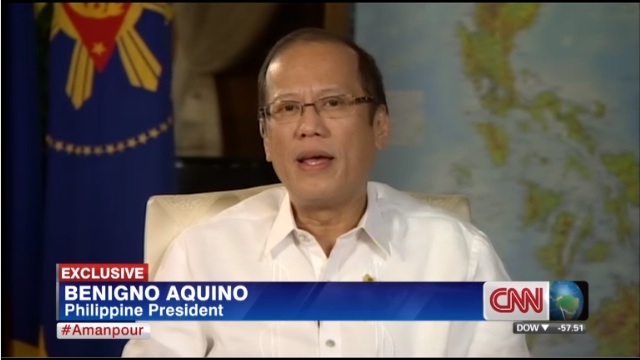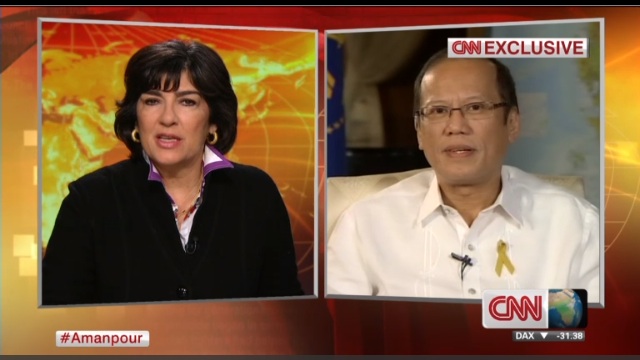SUMMARY
This is AI generated summarization, which may have errors. For context, always refer to the full article.

MANILA, Philippines (UPDATED) – President Benigno Aquino III said the actual death toll from the devastation of Super Typhoon Yolanda (Haiyan) is lower than the 10,000 earlier estimated by local officials.
“10,000 I think is too much. And perhaps that was… brought about by being at the center of destruction… there’s emotional trauma involved with that particular estimate,” Aquino told CNN’s Christiane Amanpour late Tuesday, November 12.
The National Disaster Risk Reduction and Management Council later confirmed the President’s figures.
As of 4 pm on Wednesday, it had confirmed that 2,344 were killed, 3,804 were injured, and 79 were missing.
Most of the fatalities – or 2,161 – were recorded in Region VIII or Eastern Visayas, the region hardest hit by the super typhoon. They were:
- at least 1,068 in Leyte
- 696 in Tacloban City (in Leyte)
- 21 in Ormoc City (in Leyte)
- 200 in Samar
- 172 in Eastern Samar
- 4 in Biliran
The rest of the casualties were:
- at least 68 in Cebu
- 44 in Capiz
- 41 in Iloilo
- 10 in Aklan
- less than 10 in other provinces
Yolanda, said to be the strongest typhoon to have made landfall in recorded history, decimated large swaths of the Visayas. Its worst effects were seen in Eastern Visayas, where the combination of winds 235 km/h upwards and storm surges of up to 5 meters high leveled entire communities to the ground.
Aquino said the officials who gave the high death toll “did not have basis.” “They were too close to the center,” he said, referring to the officials.
He said the number the government is working on right now is between 2,000 to 2,500. “We’re hoping to be able to contact something like 29 municipalities left, wherein we still need to establish the numbers, especially for the missing,” he said in the interview.
‘Moral responsibility’
Climate change, Aquino insisted, is also to blame for the disaster, and he hopes the ongoing UN climate talks in Warsaw, Poland, would come up with a solution.
“I think it is already an accepted reality for the Filipino community that global climate change is a reality, and that there should be no debate that this is happening,” he said.
“We all live in one planet; either we come up with a solution that everybody adheres to, operates with, or let us be prepared to meet disasters, ever increasing disasters at a global level,” Aquino said. (READ: PH negotiator calls for end to climate crisis ‘madness’)
He said developed countries who are the biggest contributors to global warming should be more conscious of their decisions that impact the planet.
“Especially to the most developed countries that are contributing immensely to global warming, there has to be a sense of moral responsibility that what they wreak is playing havoc on the lives of so many others incapable of defending themselves,” he said.
‘Simply overwhelmed’

Aquino again emphasized that local governments are supposed to be on top of initial disaster response, but pointed out the local governments – particularly in Leyte, Eastern Samar and Samar – were “simply overwhelmed” by the onslaught.
“The national government did not just have to augment what the local government could do, but also replace a lot of personnel with personnel from other regions, to take care of the government’s vital functions,” Aquino told Amanpour.
The security situation in the affected areas is also due to the collapse of basic services supposedly provided by the local governments due to the typhoon.
“The local government unit, acting as first responders, failed to respond appropriately – then there was that break down. People became desperate, and that’s why we are trying to fast track the situation where the national government takes over local government functions,” he said.
In terms of disaster risk reduction, he said there have been improvements already, adding that most affected areas had minimal casualties, with the exception of the 3 Eastern Visayas provinces hardest hit.
“The knowledge imparted to all of them really helped reduce the impact,” Aquino said, referring to projects such as geohazard mapping.
The challenge, the President said, is the rebuilding efforts for tens of thousands of families affected.
“[It is] quite a major outlay, and then the construction has to be better to withstand the ravages of this climate change,” he said. – Rappler.com
Add a comment
How does this make you feel?
There are no comments yet. Add your comment to start the conversation.